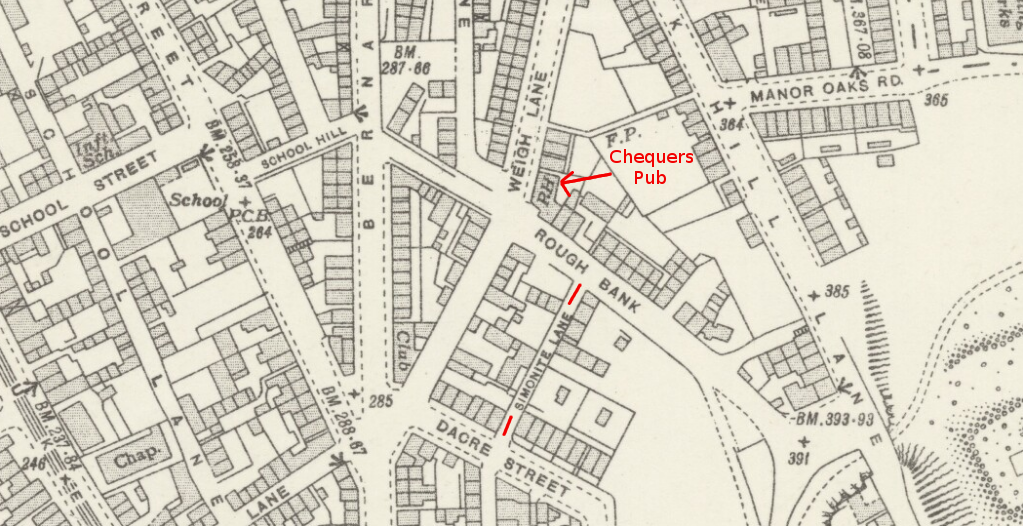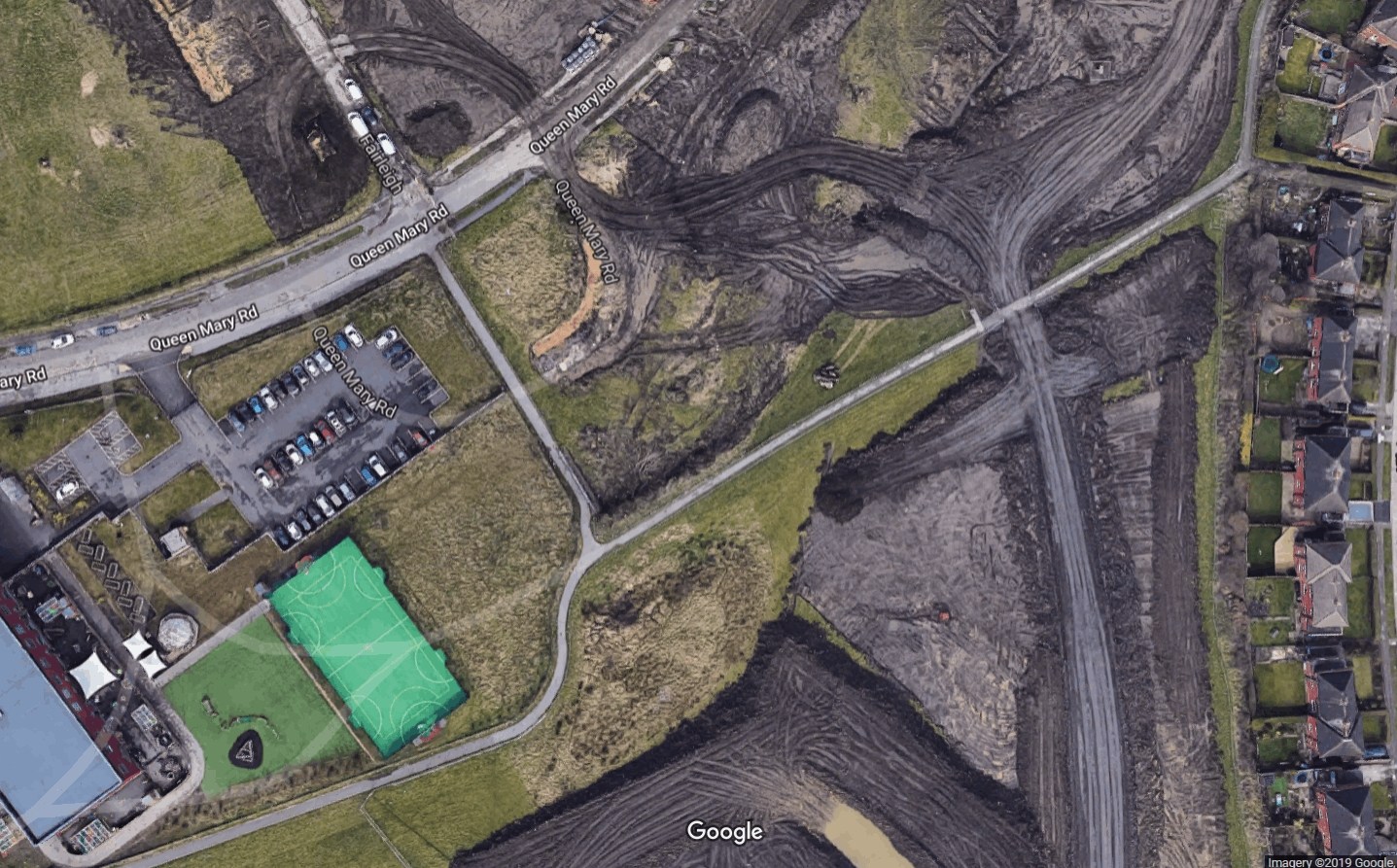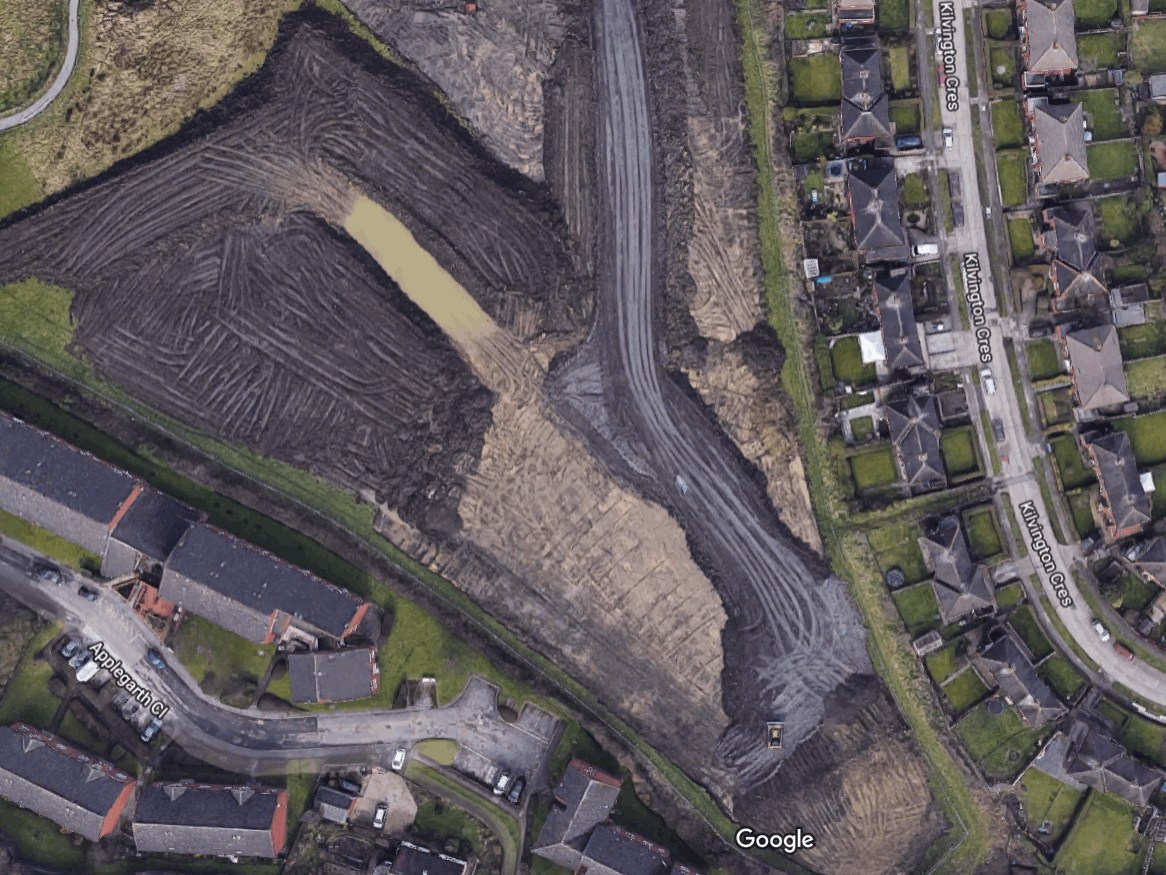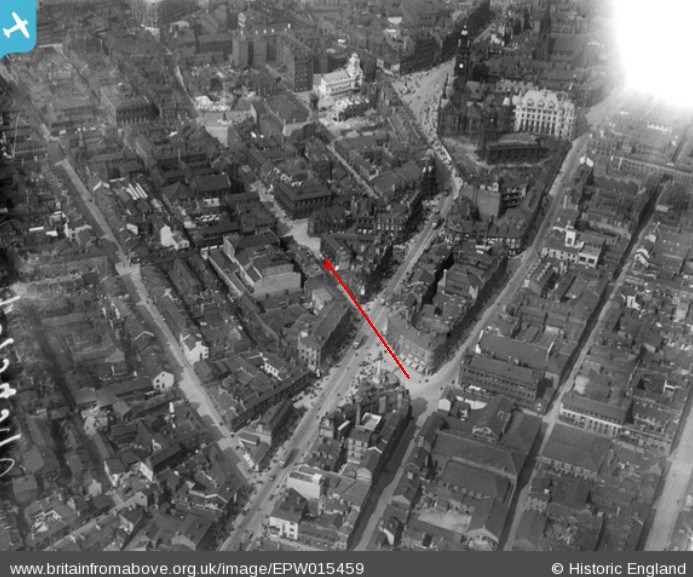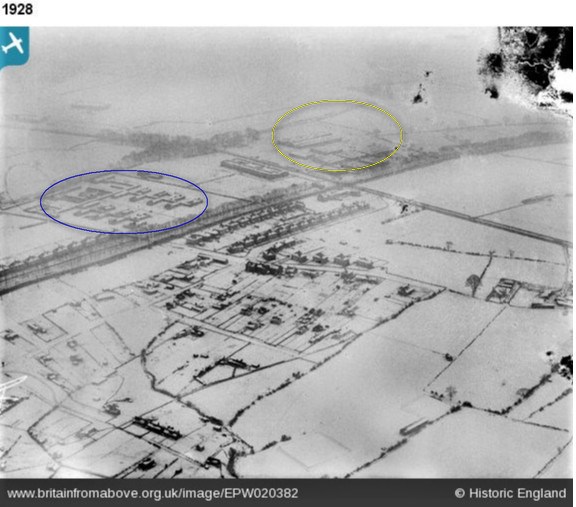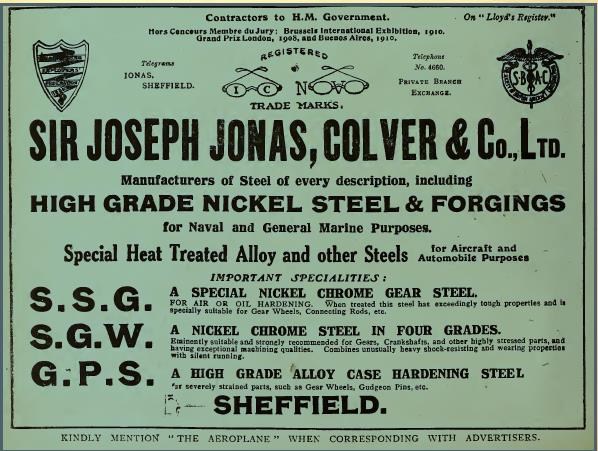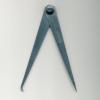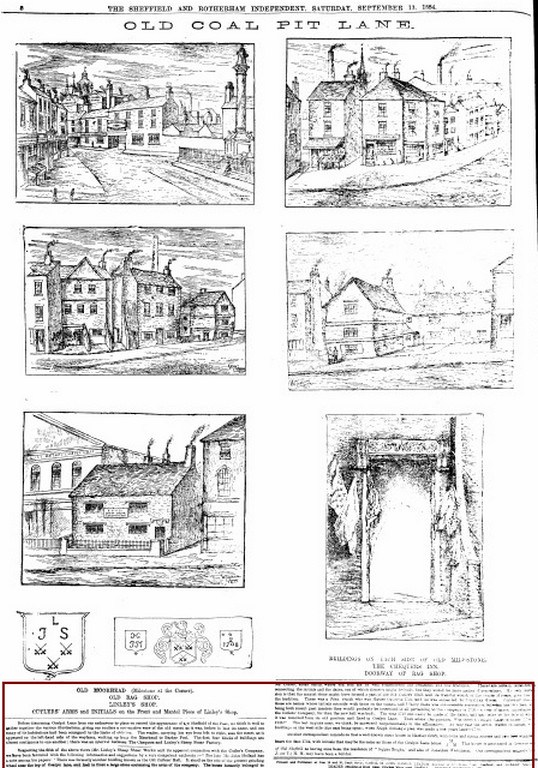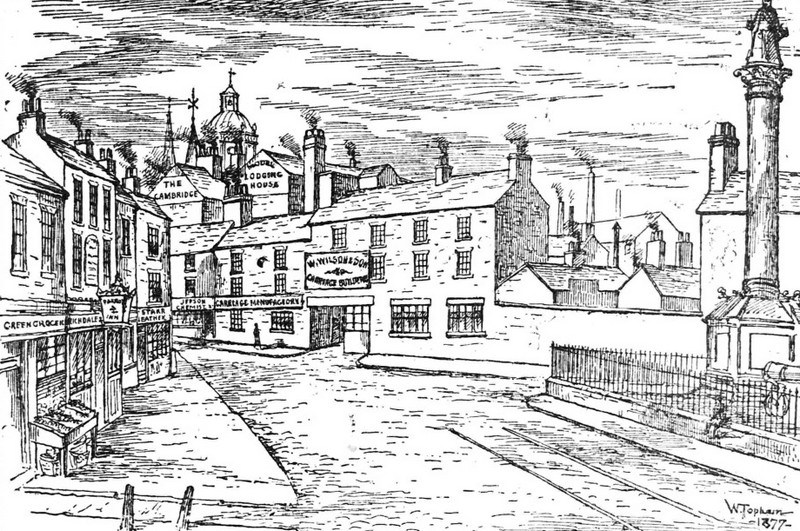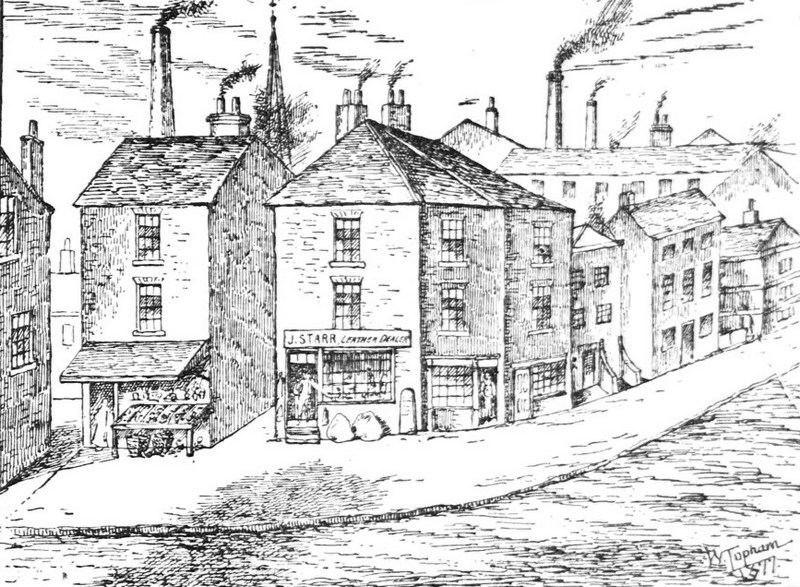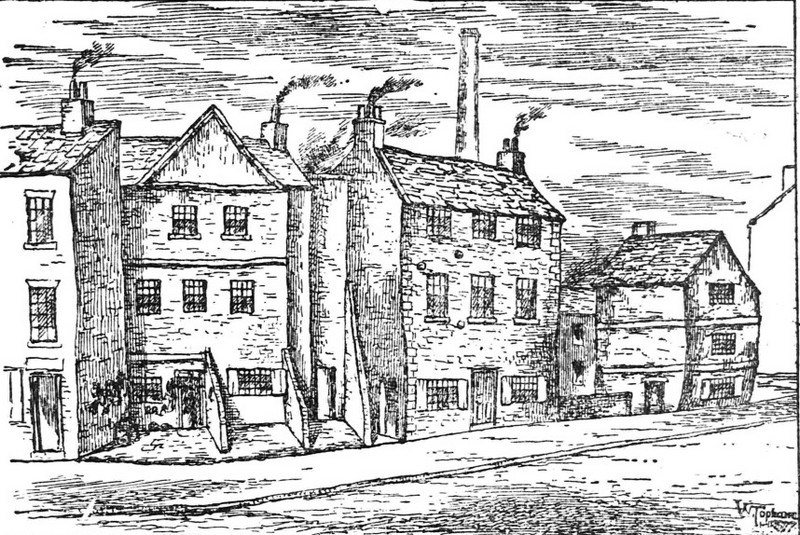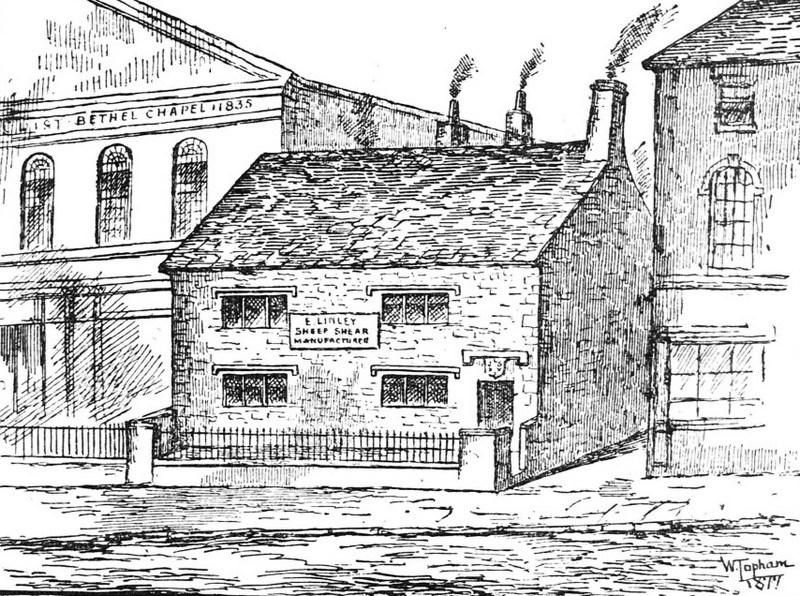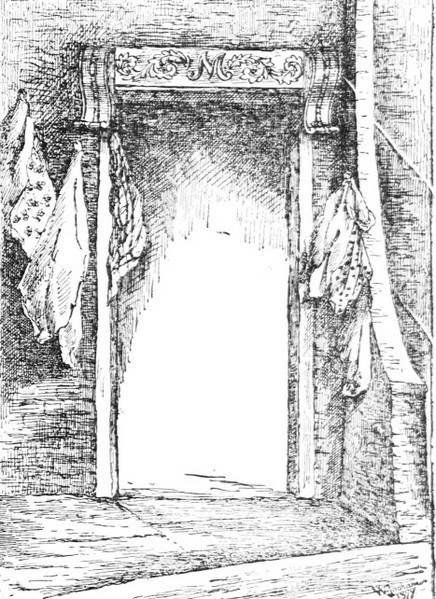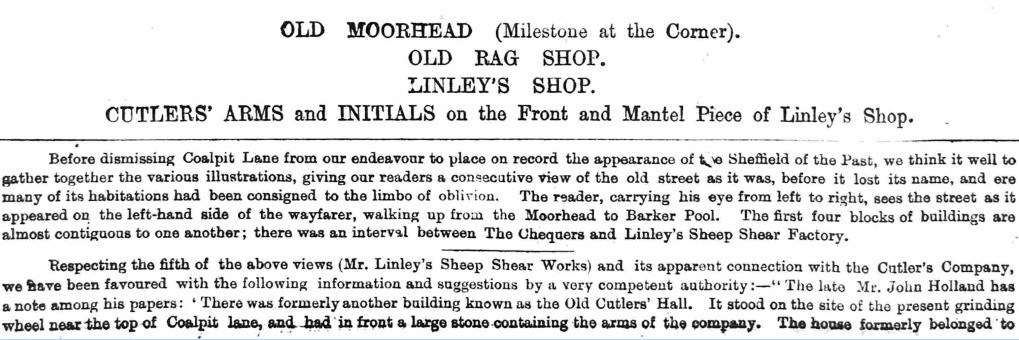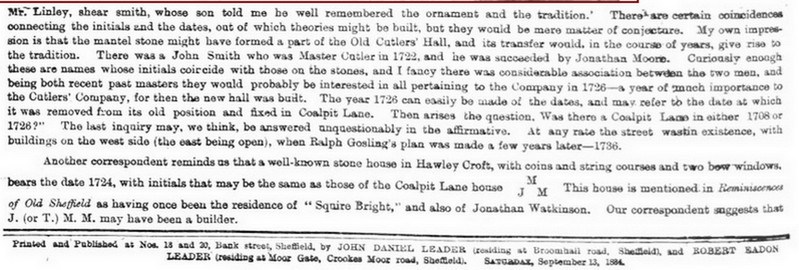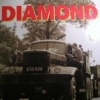Search the Community
Showing results for 'coal pit lane'.
-
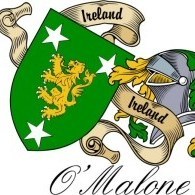
Derivation of the 'Main' suffix in the mining industry.
tozzin replied to 100GroundsProject's topic in Sheffield History Chat
I think it means the pit is sunk on the Main coal seam. -
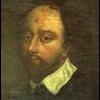
Derivation of the 'Main' suffix in the mining industry.
History dude replied to 100GroundsProject's topic in Sheffield History Chat
Is it to do with the main seams of coal they sit on? -
That must be a reference to the Chequers Pub just past Weigh Lane going up Rough Bank. Plenty of Simonites around the area in the 19th and early 20th Centuries, here are just some from directories of the time and below is Simonite Lane on a 1935 map. 1833 Simonite Joseph, table blade forger, Rough bank, Park 1845 Simonite, Joseph, table knife maker, Rough Bank Park 1854/6 Simonite Isaac, grocer &c. 63 Broad Street, Park 1862 Simonite Isaac, 59 Broad Street, beeerhs 1879 Simonite Arthur,13 Bernard Lane, table knife ctlr 1879 Simonite Mrs. 1 Rough Bank, Eliza Shopkecper 1879 Simonite Isaac, coal dlr. & carter, 3, Court 10, Park Hill Lane. 1901 Simonite Thomas, 61 Staniforth Lane, cart owner 1901 Simonite Herbert, 22 Talbot Road, labourer 1901 Simonite John, 73 Weigh lane, shopkeeper, coal dealer & beer retailer, 1901 Simonite Thomas, 61 Staniforth lane Pk. cart owner, 1905 Simonite Leonard, 33 Rough Bank, shopkeeper
-
Recent Google images of the area show that construction work has revealed several interesting features. The first image at the top some brickwork remains of the pit. Two white rectangles are I think fenced off areas, these could be to do with the works or could be something that they have found, such as pit shafts or drain covers. Notice too the very black soil, indicating the presence of coal dust. The Orange object is an excavotor. The second image shows the school car park recently extended. The third shows the former school fields. Clearly a large collection of clay coloured water has developed in the middle. In the middle of the brown soil area you can see straight lines. These could be field edges if they were not caused by the work itself.
-
Well spotted, I missed the sign, so perhaps not a very temporary thing like site entrance. I am sure the name of the arcade is related to Cambridge Street (previously Coal Pit Lane) but have never seen any evidence of an earlier road just where the arcade was. Pinstone Street as we know it didn't appear until after 1880 and I think the arcade was built soon after that. Up to 1960 Cambridge Street lined up just about directly with the top of the Moorhead triangle that surrounded the Crimea Monument and I may be wrong but think the addresses on that bit were Moorhead. This photo' from an earlier post probably explains better what I mean ---------------- https://www.sheffieldhistory.co.uk/forums/topic/16570-a-birds-eye-view-of-old-sheffield/?tab=comments#comment-139917 ------------------ and this other early post has some good information about the general area --------------------- https://www.sheffieldhistory.co.uk/forums/topic/15327-68-pinstone-street-in-1881/?tab=comments#comment-131019
-

Does anyone know where this was?
southside replied to Sheffield History's topic in Sheffield History Chat
Meadowhead Crossroads photographed from above in the winter of 1928 (Britain From Above) Coal Aston Aerodrome circled yellow, Painted Fabrics circled blue. -

Mount Zion, Wesley Tower, Lydgate Lane.
Edmund replied to boginspro's topic in Sheffield History Chat
Probably a beacon for celebrations, as the location is visible for miles around. For the Diamond Jubilee in 1898 two bonfires were set up - at Mount Zion and Sky Edge - each 20 to 30 tons, 19 feet high, 20 feet in diameter, made of timber, tar barrels and 2 tons of coal. Another possibility is a cage for sightseers to stand safely with their telescope. Lincoln cathedral at a distance of 40 miles was visible. The building was previously called Cross Hill, (note Cross Lane still leads towards Crookes) but after alterations in 1865 which added the tower, was renamed Wesley Tower. Mr Howlden made this change in reference to his mother Ann Howlden's meeting with John Wesley. In 1782 Wesley was preaching in Norfolk Street Chapel, and on leaving he saw a little girl in the crowd, who he spoke with and gave a sixpence. She was Ann Howlden and she became a lifelong Methodist until her death in 1867. -
There are many posts on this very site mentioning Coal Pit Lane and containing probably more information in one place than you will find anywhere else EllisSearcher . Here is a link to search results I have just done, I hope you find something useful in that lot --------- https://www.sheffieldhistory.co.uk/forums/search/?q="coal pit lane"&sortby=relevancy
-
Coal Pit Lane became Cambridge Street
-
As most of my family appear to have lived around what is now Upperthorpe, Netherthorpe, through to the town centre along Solly Street and Townhead Street, I was hoping to find Coalpit Lane near there as I have a branch of my family living there. I know roads ‘disappear’ over time and wondered which map I should look at to see if there ever existed Coalpit Lane in this area. Any suggestions would be greatly appreciated. Thanks
-

Was this building a court house?
boginspro replied to Thorntons girl's topic in Sheffield History Chat
I think you are thinking of Parade Chambers at the corner of East Parade, by M.E. Hadfield & Son, built 1883-85, for Pawson and Brailsford, printers and stationers Cairns Chambers were designed by Charles Hadfield and built between 1894 and 1896 for Henry & Alfred Maxwell, solicitors and later used by Hadfield and Cawkwell, architects and many others. By 1905 there were at least ten companies with offices in there, the majority having the address of "Cairns Chambers, 19 St. James Street" but I see that the Sheffield Coal Company address was Cairns Chambers, Church Street on the post by RLongden -

Were children employed in the Sheffield steelworks?
Stunmon posted a topic in Sheffield History Chat
After visiting the wonderful Coal Mining Museum in Wakefield and realising the extent of child labour, I wondered if children had been used here in Sheffield in the steel works or other kinds of industry? -
There were many coke ovens about at the time, so you would need to find archived documentation. I think it may be too early for Beighton Colliery ( or later Brookhouse ). The ones that spring to my mind near Beighton, which I think had coke ovens at the time are Hollbrook, Norwood, Wiggin Tree, Birley West, possibly Fence and Orgeave as mentioned above. I have not looked it up but I am sure there were many more with coke ovens, coke was in big demand for steel production. At that time Birley West was a large producer of coke from the Silkstone Seam and had 129 beehive coke ovens. I would think that some Beighton men would have worked there, just a short walk through the Shire Brook valley or a ride on the train up the branch line through Birley East. Though no coal came from that pit after 1908 the coke ovens produced coke from the other Sheffield Coal Company pits until about 1918. There are so many places he could have worked, hopefully some of our experts on here may know where records can be found.
-

Lost Railways Sheffield on Channel Five
Old rider replied to History dude's topic in Sheffield Buses, Trams and Trains
The freight traffic was mainly coal from the Wath on Dearn marshalling yard going to power stations etc. on the other side of the Pennines. One of the features of the D.C. system was that when the Locos of freight trains were on the long descent out of the tunnel and past the reservoirs towards Manchester the D.C. motors generated power back into the system. Thereby helping power the trains climbing the slope. Why did the locos need replacing when they ran on the Dutch railways after closure of the Woodhead route? -
I was a member of the project team which aimed to unravel the mystery of Norton and Coal Aston’s lost airfield (see https://www.ukeconet.org/nortonflyinglegacy.html) for the report on the project which was managed by the Landscape Heritage Research Foundation with Heritage Lottery Fund support. As part of the project I reviewed several volumes of "The Aeroplane" magazine, and present here extracts from the period 1915-1918, which relate to Sheffield. Included at the end is “The Sir Joseph Jonas Case” – which I find fascinating. Extracts from The Aeroplane Vol 8 (Vol VIII) 1915 to Volume 15 (XV) 1918 FOR AIRCRAFT PARTS. Aircraft constructors will do well to note that the Sheffield-Simplex Motor Works, Ltd., of Tinsley, Sheffield, are prepared to assist in the acceleration of the output of aeroplanes in their sheet metal working and autogenous welding department. The high quality of Sheffield-Simplex productions need not be extolled here. It is sufficient to state that the firm are qualified to undertake the most exacting work. Undoubtedly a number of contractors who have undertaken to construct complete aeroplanes have "bitten off more than they can chew," and, if some of their intricate metal work were put out to competent firms, deliveries would be materially expedited. The Sheffield-Simplex Company are anxious to receive early inquiries, because, if encouragement is received, they are prepared to launch out on this specialised work on a large scale. The Aeroplane, Vol IX, p524, 27 October 1915 GERMANY – Communique issued on February 1st :— On the night of January 31st one of our naval airship squadrons dropped large quantities of explosives and incendiary bombs on the docks, harbour, and factories in and near Liverpool, on Birkenhead iron foundries and smelting furnaces, on Manchester factories, on smelting furnaces at Nottingham and Sheffield, and the great industrial works on the Humber and near Great Yarmouth. Everywhere marked effects were observed in gigantic explosions, and serious conflagrations. On the Humber a battery was also silenced. Our airships were heavily fired on from all directions, were not hit, and safely returned. The "Hamburger Nachrichten" of February 7th said :— "In England the people were living happily and free from care in the midst of war, while labourers were earning good money. Then the Zeppelins came out of the night and taught the haughty people that the war can overtake them anywhere and that it is bloody, terrible, and serious. England's industry to a considerable extent lies in ruins. England's own soil has been ploughed up by the mighty explosive shells of German air squadrons. "Over England herself during the night there was a fierce and hard-fought battle, a devastating air-battle fought on a front of many miles, and it was won by German airships. They returned proud and safe from the fierce battle. England can now contemplate the ruined centres of her industry and trade, to which she has been brought by the wicked policy of her statesmen." Aeroplane Editor commented: Probably quite as accurate as most of the stuff that appears in the English papers.—Ed. The Aeroplane, Vol X, p242, 9 February 1916 Recruits for R.F.C. Prospective recruits for the Royal Flying Corps in the Sheffield district should note that a R.F.C Special Recruiting Officer will be at the Recruiting Office, Corn Exchange, Sheffield, until the 15th inst. The recruiting and examining party will later visit Stockton-on-Tees, Carlisle, and Glasgow. There are other recruiting parties at present stationed at Leeds, Manchester, Birmingham, and London, the addresses of which can be obtained from the general recruiting offices in those towns. The Aeroplane, Vol XI, p56 12July 1916 AN EXHIBITION OF WAR WORK. An important official exhibition was opened on Wednesday Sept. 26th, at the Mappin Art Gallery, Sheffield, where samples of women's work, in connection with munition making, together with photographs of the different processes, are on view. The exhibition is under the aegis of the Labour Supply Department of the Ministry of Munitions, and, as three sections are devoted to aircraft work, those interested in the manufacture of aeroplanes, engines and their parts, in the Sheffield district, are strongly recommended to pay a visit. In the engine section are photographs and specimens illustrating the various operations entailed in the manufacture of parts of Clerget, R.A.F., Beardmore, Gnome, and le Rhone engines details being given of the nature of the tool or tools employed, the limits of tolerance allowed, the time taken to perform the operations, and the manner of setting up the tools. In a similar way, sections of the exhibition are devoted to aircraft fittings (metal), and to aircraft woodwork, and samples are shown both of tinclips and wood members, many of which are made completely by women, and under female supervision. The exhibition will be open until October 9th, and it is hoped that it will be well attended, not only by woman munition workers and prospective workers, but by the employers of labour who are still sceptical as to delegating important and accurate work to woman workers. The Aeroplane, Vol XIII, p996 3 October 1917 AIRCRAFT STEELS. A catalogue issued by Messrs. Edgar Allen and Co., of Sheffield, gives particulars of nickel, nickel-chrome, chrome-vanadium, and other steels of their manufacture suitable for motorcar and aircraft purposes. In the case of motor-cars there is a table showing which variety is adapted for use in the different parts of the engine, transmission, axles, and chassis and steering gear, and for some parts alternative recommendations are given, the use of one variety being advised when it is desired to have the best, as for racing or high-class touring cars, while another, or sometimes two, is suggested when cost is important. For many of the steels details are given of their behaviour under tensile, torsion, and hardness tests, and also of the heat treatment to which they should be subjected. Another table summarises the physical characteristics of steels prepared in accordance with the specifications of the Engineering Standards Committee, the Air Board, etc., and shows the equivalence between these steels, which the company also make, and their own special products. The Aeroplane, Vol XIII, p1344 7 November 1917 THE W.R.A.Fs. AND FLYING. Apropos the statement made by the Minister of Labour at Sheffield on June 3rd, in regard to a Woman's Air Force, Maj. Baird, Parliamentary Secretary to the Air Ministry, stated in the lobby on June 4th that such a force was really in existence already, holding a position corresponding with that of the W.A.A.C.s. in relation to the Army. There was no reason whatever, he added, why women should not fly quite as well as men. Indeed, they performed the work assigned to them admirably, but there was, "of course, no idea of sending them to fight at the front. The intention rather was to release men for duties of a more arduous nature. The thing was not being done under any definite scheme, for which at present there was no necessity. Aeroplane Editor commented: [There is perhaps no reason why any W.R.A.F. should not do anything as well as Maj. Baird does it, but that is no reason for risking valuable aeroplanes in the care of women pilots when there are plenty of men to fly them.—Ed.] The Aeroplane, Vol XIV, p2148 12 June 1918 SIR JOSEPH JONAS' CASE. It is officially announced that the King has been pleased, by Letters Patent under the Great Seal of the United Kingdom, to degrade Sir Joseph Jonas from the degree of Knight Bachelor. One assumes that his Majesty acted on the initiative of his political advisers, and not of his own knowledge of the facts. Sir Joseph Jonas was 'recently convicted at the Central Criminal Court, London, under the Official Secrets Act, 1911, of misdemeanour, in that he aided and abetted Charles Alfred Vernon unlawfully to obtain information respecting Vickers' rifle works at Crayford, Kent, which was calculated to be useful to an enemy. He was fined £2,000. A former Lord Mayor of Sheffield, he was 'chairman of the firm of Sir Joseph Jonas, Colver, and Co. (Limited), steel manufacturers, and has for many years occupied a leading position in Sheffield. Born at Bingen-on-the-Rhine in 1845, he came to this country when he was 21, and was naturalised in 1875. He was first German Consul in Sheffield, and during his Lord Mayoralty received from the Kaiser the Order of the Prussian Crown. He was knighted by King Edward in 1905. The last case of degradation from knighthood, and the first for very many years, was that of Roger Casement, who was hanged for high treason, and one cannot bring oneself to regard this as in any way an analogous case. Sir Joseph has been for many years admired and respected in Sheffield, where his personal generosity and his public spirit won for him a high place in the esteem of all classes. His business acumen and industry created a great business, which to-day gives employment to a great number of people, and provides this country with valuable war material. His offence was one which is committed constantly in time of peace by firms in fierce competition with one another, and it does not seem possible that it had any evil results. It was committed long before the war, and during that same period a British armament firm of the highest standing was actually supplying to the German Government quantities of their latest type machine-guns, which the War Office refused to buy for the British Army. These British guns have been used against British troops in this war, yet nobody is punished for letting them go abroad. Sir Joseph Jonas, despite all his good work, is heavily punished for an offence of far less magnitude. It is not surprising therefore to hear that the opinion in Sheffield is that the whole of Sir Joseph's case was brought up because he offended certain Government officials or their friends. The Aeroplane, Vol XV, p880 4 September 1918 The site: http://www.chrishobbs.com/sheffield/josephjonas.htm has further details of Sir Joseph Jonas.
-

Coal Aston Aerodrome, and Alcock and Brown
lysander replied to Henry Pond's topic in Sheffield History Chat
Coal Aston Aerodrome saw "A" flight of No 33 squadron RFC tasked with the training role but also making nocturnal anti Zeppelin sorties with Home Defence during WW.1. With the signing of the Armistice the airfield found itself being used for aircraft storage. The airfield saw many flying events( Flying Weeks) during the 20's including the previously mentioned Vickers Vimy which made a record flight from Sheffield to London of 95 minutes!!! Most widely remembered were the appearances of Sir Alan Cobham and his "Flying Circus", greeted by Sheffielders in their thousands. In 1920 the Sheffield Act gave the Corporation powers to acquire Coal Aston Aerodrome which figured in the attempts by the Corporation to provide the City with an aerodrome and ancillary services...after promptings by the Air Ministry. The Air Navigation Act of 1920 already empowered the Corporation to build an aerodrome there...but as with so much else, they pontificated.... in 1931 employing Sir Alan Cobham to survey and inspect a total of 9 other sites. In the end, he settled on Coal Aston even though forces were already moving to build the City's southern hospital on the site. Nothing happened and for the sum of just over £3,000.00 the City gave up on an aerodrome and the land ended up being the site of housing,( it has to be said the City Treasurer was unconvinced of Cobham's estimated cost, They suggested a sum of £ 56,131.00 which included the cost of land already acquired by the Corporation.) The site was situated on the 600ft contour line, lying in the Norton/Dyche Lane area and would have had two runways of 900 and 1,300 yards in length . Note it should not be confused with the much later WW2 vintage RAF Norton,,,a barrage balloon depot.( as a matter of interest there exists another Coal Aston landing strip which still receives the very occasional traffic. This is situated close to Apperknowle in NE Derbyshire.) From: The Aviation Wilderness by Stewart Dalton...no longer in print. -

The history of Robin Hood at Normandale House in Loxley
R0BIN replied to Sheffield History's topic in Sheffield History Chat
I think with the council, it is a case of "do as I say, not as I do." Credit due though, they do take into consideration the age of the tree and whether or not it poses a risk to the public. I always think of meat stews when I read about Haggas Croft. I don't know if you are aware that Loxley falls within ancient Northumbria. The boundary is the River Don. The field system is the same as the Scots method of farming. But thinking about the coal and ganister that was extracted, I am sure the area was extremely rocky. -
Having a taste for savoury foods I've always been fond of cream crackers with cheese. This last couple of years I've been disappointed to find that cream crackers of any brand are now baked to an insipid off-white colour instead of the rich golden brown that they used to be. They don't crunch any more but rather melt into slush under your molars. I used to enjoy the cheese flavoured "Chedders" but they too, seem to be baked to a Dulux Colour Chart shade of off/white magnolia and are so bland as to make you retch. My solution is to properly bake the crackers , ten at a time, under the grill to a rich golden brown. Don't tell anyone, the Food Police will be knocking at my door. It would appear that the "Food Police" have ruined things yet again by instructing manufacturers not to bake food as they used to in case it produces acrylamide, a substance that might, possibly, perhaps, cause cancer if administered to rodents in MASSIVE doses. We can't have suger in our drinks any more, must not drink more than one unit of alcohol every Preston Guild and chips apparently cause instant death. We don't eat ready meals, I eat lean red meat almost every day and consume quantities of full-fat cheese, my cholesterol levels continue to amaze my GP, coming in south of 4.5 every time. The local Lincolnshire sausage can be grilled to a nice deep chocolate brown and is very tasty if you ignore the green bits in it. For the first twenty years of my life, breakfast consisted of toast done with a long home-made toasting fork in front of a coal fire. The best efforts produced toast that varied across the slice from raw bread to carbonised charcoal. I might not live to be a hundred and twenty, (who would want to), but at least I will have enjoyed my food. hilldweller
-

Potential bomb shelter in our garden?
unrecordings replied to mounsey's topic in Sheffield War Years and The Sheffield Blitz
Does anything on the Coal Authority mapping come close to your location ? http://mapapps2.bgs.ac.uk/coalauthority/home.html -
My grandparents, Samuel and Abigail Brady lived on the corner of Mundella Place and Derbyshire Lane, before they died prior to WW2. Officially he was the caretaker but his wife was a matriarch, running a business (coal/greengroceries, etc) and I am sure she would have been very much involved in the school. My mother, Alice Brady, one of their children, were living with her husband Fred Roe,in the house on one of the blitz nights. My 3 year old brother was their only child at the time. The house, it is said, had a direct hit and was reduced to rubble. However, the 3 of them had been sheltering in next door's reinforced cellar. They had to be retrieved through the cellar grate. My father returned from barrage balloon duty to see the bedroom curtains in a tree! My Aunt who was in the cellar of her home at 233 Derbyshire lane, says that next door (where there was a garage, when I last visited UK from Sydney) also had a direct hit.
-

From The Moor and Charter Square to Cambridge Street and Barkers Pool
southside replied to Sheffield History's topic in Sheffield History Chat
This article appeared in the 1884 Sheffield & Rotherham Independent. It trace`s the route taken by yourself along Cambridge Street or as it was in earlier times Coal Pit Lane. -

What's the most mysterious Sheffield place you can think of?
tozzin replied to Sheffield History's topic in Sheffield History Chat
The last time I passed this building someone was living in it but if anyone is interested here's a list of residents of Shrewsbury Road: Notice that the road name after Shrewsbury starts with a small "s" as it does for lane, street etc. I don't know when that practice stopped and capital letters were used. 1849 NO HOUSE NUMBERS Wilson Joseph Bousfield, clerk, 7 Shrewsbury road Goodlad William, clerk, 9 Shrewsbury road Dudley Guilford, clerk,11 Shrewsbury road Charles A. F. teacher 13 Shrewsbury road Goode Barney, gardener, Shrewsbury road cottage Hall Miss Mary, Farm bank, Shrewsbury road Lockwood Mrs Ann, Farm bank, Shrewsbury road Roberts John, silver & plated ware manufacturer; h Shrewsbury road 1852 NO HOUSE NUMBERS (Farm bank) Woodhead John, clerk Raworth B. P. manufacturer Fawkes Mrs E. school teacher (She ran a Ladies School from this address) Smith Marcus, surveyor Booth Luke, manufacturer Rossell Henry, manufacturer = this may be No 19 Lowe Thomas, manufacturer Hall Miss Mary (Farm Bank) Favell Mrs E Irving Nathaniel, manufacturer Wilson J. B. clerk Whittaker Mr John Baines Wm. N. traveller Wade :Mr John Simmonett John Charles A. F. school Harrison A. E. school Brown John, traveller Wharton George, manufacturer 1879 5 Oldfield Mr Thomas 5 Oldfield Frederick, pianoforte tuner (possible son) 7 Walker Edward, file cutter 9 Ellis William (potato merchant) 11 Ward Jonathan. N. commercial traveller Granville lane 19 Dealey & Horner, joiners & builders 21 Robinson John S. manager 23 Morris Mrs Amelia 25 Wilson Mrs Ellen 27 Gillott George Wm. (junior) pearl fluter 29 Horrax John, manager 31 Wood John, cashier 33 Jackson UNITED METHODIST FREE CHURCH South street and Talbot street Granville road 2 Curtis John B. station master, Midland Railway Co 4 Leffler Rudolph, iron and steel merchant Farm Bank road 8 Jones Philip, (junior) silver engraver 10 .Bailey Francis, mason 12 Henson George, clerk 14 Haywood John, (junior) silver plater 16 Southwick Mrs Mary 18 Wilson Wright, surgeon 20 Mammatt William (silver plated goods manufacturer) 22 Barnard Frederick, engine tenter Hall Benjamin, (junior) silversmith Claywood lane, Claywood quarry, and Norfolk road 1893 WEST SIDE here is Granville street 3 Stocks Charles 5 Foster Mrs 7 Hunt Oliver Joiner 9 Nicholson Arthur Manager 11 Osborne Arthur 13 McDougall Alfred E.L. Printer 15 Prince Joseph Manager 19 Dealy Fraser Joiner & Builder 21 Pattinson Arthur Metal Smith 23 Schofield Mrs 27 Lawson John Manager 29 Oakes Henry 31 Jones Mrs Jane UNITED METHODIST FREE CHURCH EAST SIDE here are Farm road & Granville road 2 Wheen Henry Lawrence Station master Midland Railway 4 Owen George Bargh (correct name !) here is Farm Bank road 8 Hollingsworth William 10 Wilkinson Henry Penknife blade manufacturer 12 Cowley Ernest John Mason 14 Kitson John 16 Brown Samuel Mason 18 Rhodes Tom Manager 18 Naylor George 20 Green Charles Pattern maker 22 Smith Walter Basket maker 24 Page William Commercial Traveller 26 Hall Benjamin 1901 Granville street NO NUMBER 19 LISTED 1 Shaw John Arthur, (j) edge tool.forger 3 Stocks Charles, (j) roller turner 5 Whitton George, (j) steel roller 7 Hutchinson Albert Edward, (j) silversmith 9 Nicholson Arthur, manager 9 Nicholson Mrs Jennie, teacher of music 11 Osborne William, draper 13 MacDougall Alfred E. printer 15 MacDougall Allan, printer 17 Backhouse Miss Ellen, confectioner Granville lane 21 Pattison Arthur, (j) metal smith 23 Watkins James, guard 25 Bower Frederick, (j) blade maker 27 Smith Frederick. Wm. paperhanger 29 Chandler Thomas Edward, clerk . 31 J ones Mrs Jane, apartments 33 Wright Robert, day missionary UNITED METHODIST FREE CHURCH South street ............... Norfolk road ................ . Granville road 2 Wheen Henry L. Midland Railway station master 4 Bird Richard, Midland Railway engineer Farm Bank road 6 Snowden William, fruit merchant 8 Hollingsworth William, tailor 10 Wilkinson Henry, (j) forger 12 Hall Paulinus, clerk 14 Cowley Ernest John, (j) mason 16 Crapper Ellis, oil merchant 18 Green Charles, sculptor 20 Dixon Mrs. Elizh. Mary, apartments 22 Smith Walter, (j) basket maker 24 Scorah Mrs Eliza 26 Hall Benjamin, (j) silversmith Claywood lane 34 Barker Miss Eleanor, apartments 36 Godfrey Jas. Briggs, woollen merchant 38 Angell Wilfred Lawson, fruiterer 1905 NO NUMBER 19 LISTED Granville street 1 Sanders Harry, foreman 3 Stocks Charles, (j) roller turner 5 Kelly Nicholas James, stoker 7 Wyatt Charles, (j) bricklayer 9 Nicholson Arthur, manager 9 Nicholson Mrs Jennie, teacher of music 11 Osborne William Draper 13 MacDougall Alfred E. printer 15 MacDougall Allan, printer Granville lane Dealy Francis, joiner 21 King George Henry. coal merchant 23 Watkins James, guard 25 Bower Frederick. (j) blade maker 27 Hawke Mrs Emma Jane 29 Staniforth Charles, (j) butcher 31 Jutsum Wm. John, assistant Schoolmaster 33 Pollitt Mrs Eliza, shopkeeper UNITED METHODIST FREE CHURCH Granville road 2 Chambers Shelton, Midland Rail station master 4 Bird Mrs 6 Snowdon William, fruit merchant 8 Hollingsworth William, tailor 10 Hollingsworth Wm. Henry. tailor 12 Hall Paulinus, clerk 14 Haynes William. (j) wire drawer 16 Cowley Ernest John, (j) mason 18 Green Charles Artist 20 Dixon Mrs Elizabeth Mary 22 Smith WaIter Basket maker 24 Scorah Mrs Elizabeth 26 Hall Benjamin Silversmith 34 Crabtree Wire Drawer 36 Shevloff Benjamin Draper 38 Shakespeare William Manager 1911 NUMBER 19 IS BACK Granville street 1 Royle Harry, insurance agent 3 Stocks Charles, (j) roller turner 5 Kelly Nicholas James, stoker 7 Downs William, brass turner 9 Grindrod Alfred & Co. hot water engineers 9 Grindrod Alfred Edwin, engineer 11 Osborne William 13 MacDougall Allan, printer 15 MacDougall Alfred E. printer Granville lane 19 Green Charles, sculptor 21 Keeton Mrs Mary 23 Hallam William foreman blacksmith 25 Henson Thomas, (j) silversmith 27 Curtis Frederick, table knife forger 33 Allen Elizabeth. dress maker UNITED METHODIST CHURCH Granville road 2 Turner John Henry, chief booking clerk 4 Berrisford Joseph Wm. district engineer Farm Bank road 6 Pell Edwin Frederick. fish merchant 8 Hollingsworth William, tailor 10 Hollingsworth Alexander, tailor 12 Hall .Paulinus, clerk 14 Riley Samuel, guard 16 Cowley Ernest John, (j) mason 18 Green Charles, sculptor 20 Green W alter 22 Smith Walter, (j) basket maker 24 Scorah Mrs Eliza. 26 Hall Gilbert Claywood road 36 Shevloff Benj. lace curtain dealer 38 Shakespeare William. pattern maker -

When was this built and when did it close?
Jim Aizlewood replied to Sheffield History's topic in Sheffield History Chat
I remember when this was being built that there was a long delay due to them finding a coal seam which they had to dig out, many years later I was going down the ramp in a very old transit van with an ignition fault when it backfired just before I went under the footbridge which was full of people eating their suppers sadly most of them lost that supper due to the loud bang and big flash from the exhaust. -
George Thorpe ( a local )had the coal drops for a time in the 70's making and repairing pallets, and I was told the Simcox's (local ) built the industrial units on top after Fieldhouse Brothers had used it as a tip. My memories of Anlaby Street as a kid were painful, as I was making my way along the bottom of the Don wall, somebody decided ( my auntie as it turned out ) decided to empty her teapot over the wall of Brough Street and the contents landed on me, still hot.
-
I was down there last year, how scruffy it all is now. The photo of the school shows just how well built they were in those days and brought back many happy memories. Incidentally "Waterside Echo" was the title of our school magazine. As I started school in 1949 Neepsend Station was being demolished, the railway bridge over Parkwood Road went two or three years later. Not sure about the coal shutes and the dust,but while they were in operation as soon as the gates were shut every one was out with brushes and shovels, "cleanest road in Neepsend." Roy was in my class, I took the Central Tech exam with him along with Keith Hackett and Frank Wheldon. result 3-1 to them. I don't remember much about the practice for the Queens visit but remember seeing her at the football ground. The last time I was speaking to Roy would have been in the 80s, he had his own building firm then and was putting a large detached house up at the bottom of Industry Street Walkley. W/E.

